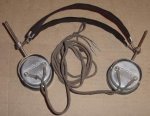190618-0825 EDT
When I made the first post my goal had been to find out what voltage was used in telegraph circuits. The link in that first post did not provide the answer, but the link was interesting so I created the post. It was late and I did not search further.
This morning I looked again and found this link
http://www.w1tp.com/pertel.htm
However, 6 V seems low to communicate over any substantial distance. No mention of ground rod resistance in the later systems that used the earth as one wire.
Modifying the search string a little more and I found this very good discussion
https://www.mikeholt.com/mojonewsar...-and-the-Modern-Telegraph-System~20050607.php
So here we see large voltages were used, thus many batteries in series, and a telegraph operator would not want to get their body across an open telegraph key.
.


